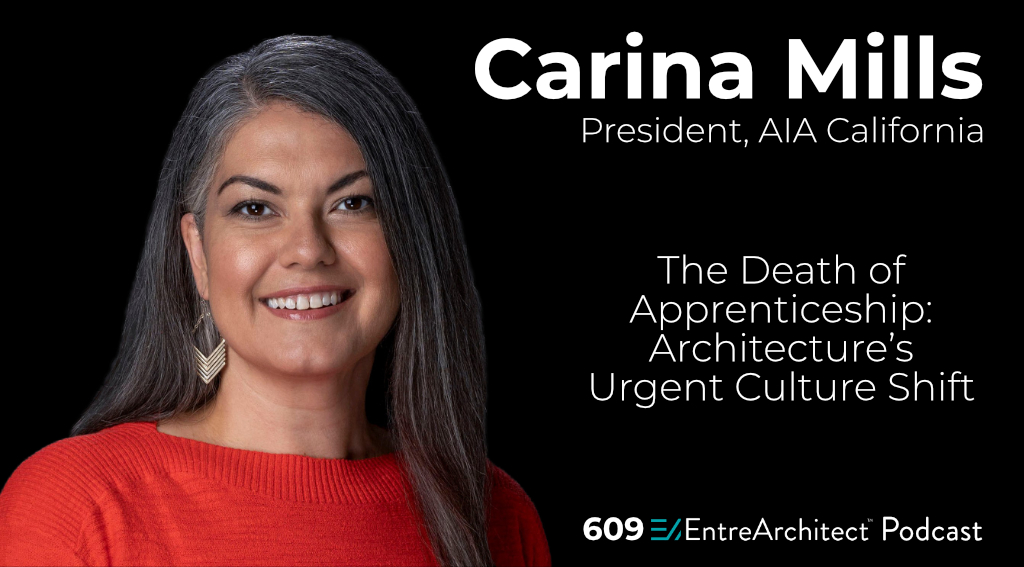
From All-Nighters to Sustainable Practice, a Generational Wake-Up Call
Architecture’s greatest strength has always been our passion, but that same passion turned into a blind spot. For generations we measured commitment with sleepless nights, low fees, and heroic “get it done” stories. That mindset shaped how studios operated and how leaders trained young architects. During my recent EntreArchitect Podcast conversation with Karina Mills, 2025 President of AIA California, we dove into a growing movement she calls Culture Shift. It is a direct response to the profession’s long-standing habits. Today I will trace the history behind that shift, highlight Karina’s insights, and show why embracing new norms is mission-critical for every small-firm architect. Listen to our full conversation at https://entrearchitect.com/609.
The Legacy We Inherited: All-Nighters and Heroics
Ask any seasoned architect about school and you will hear war stories of caffeine-fueled critiques that ended at sunrise. That ethos followed us into practice. I have lost count of the conference panels where principals proudly claimed they had never seen a forty-hour week. The unwritten rule was simple: exhaustion equaled dedication. Studios that pushed hardest believed they produced the best work. The message sent to young professionals was clear: endurance matters more than efficiency.
Cracks in the Model: Why Generations Are Opting Out
For decades the pipeline of talent seemed endless, so the profession demanded sacrifice without apology. Emerging designers today see the same bargain and choose a different path. They compare architecture salaries to tech, engineering, or product design and notice the gap. Many talented graduates leave the profession within five years because they do not see a life outside the office. Karina confirmed that trend and warned that it is accelerating. Firms that cling to the old model are losing their bench.
What the New Generation Demands
The shift in expectations is not rebellion for its own sake. It is a pragmatic correction. Rising professionals want three things: a sustainable workweek, transparent pay that includes bonuses and benefits, and a clear path for growth across design, documentation, and construction. Firms that ignore those needs watch staff leave. Firms that meet them unlock loyalty, innovation, and stronger profits.
Culture Shift Pillar 1: Healthy Hours, Healthy Profits
Celebrating exhaustion hides weak systems. Overwork often masks under-pricing, vague scopes, or reactive project management. Small firms hold a natural advantage because decision chains are short. Audit your fee structure, scope definitions, and time tracking. Set realistic schedules and hold clients to clear milestones. When people leave on time, they return the next day rested, creative, and focused. Profits rise when projects stay on scope and staff avoid burnout.
Culture Shift Pillar 2: Compensation as a Complete Package
Salary is only part of the value equation. Karina challenges principals to frame compensation as a portfolio that includes base pay, performance bonuses, paid education, flexible schedules, mentorship, and clear promotion paths. Small firms can outshine larger competitors with holistic support: closer client contact, faster responsibility, and real influence on firm direction. Make those advantages explicit during interviews and annual reviews.
Culture Shift Pillar 3: From Assembly Line to Integrated Learning
Post-war production models split studios into design, production, and construction administration teams. The approach simplified staffing yet prevented junior architects from seeing a project through to ribbon cutting. Karina calls for dissolving these silos. In small firms, one person often wears many hats. Turn that necessity into a feature by rotating team members through every project stage. The payoff is a staff that understands budgets, codes, and client relations before they take the licensing exam.
Culture Shift Pillar 4: Governance That Lets Ideas Breathe
Bureaucracy kills momentum. AIA California is streamlining its oversized board to shorten decision cycles. The same principle applies to a five-person studio. Transparent financial dashboards, rotating meeting chairs, and structured stand-ups invite fresh ideas and build shared ownership. When governance is nimble, innovation thrives.
Culture Shift Pillar 5: Competitive Flexibility
At recent AIA leadership summits, the firms winning the talent war announced four-day workweeks, cloud-first design tools, and location flexibility. Evelyn Lee reminded attendees that if you are not adjusting, your competitors already did. Recruits will not wait for legacy processes to modernize. Update your standards, software, and policies now or risk falling off shortlists.
Culture Shift Pillar 6: Peer Support Over Apprenticeship
The romantic master-and-protégé studio is mostly gone. Karina champions coaching networks where everyone learns from each other. That model mirrors our EntreArchitect Community, where principals share fee strategies while emerging pros swap digital workflows. Join or build such circles to keep your culture evolving.
How We Got Here: A Brief History
- Post-war boom introduced assembly-line production and reinforced hierarchies.
- 1960s and 70s oil crises squeezed fees, encouraging longer hours to compensate.
- AutoCAD revolution in the 1980s increased productivity but also raised client expectations, often without matching fees.
- Great Recession forced survival tactics that relied on heroic effort instead of systemic change.
- Gen Z enters the workforce and questions those survival tactics, asking for balance and transparency.
The culture shift responds to each of these milestones and corrects course.
Building Your Firm’s Future: First Steps
- Run a Culture Audit
Ask every employee two questions: “What keeps you here?” and “What might push you away?” Compare answers to your assumptions. - Rewrite One Policy
Choose hours, remote work, or continuing education and publish an updated policy within thirty days. Small wins create momentum. - Price to Protect People
Revisit your fee worksheets. If budgets assume more than forty hours, raise fees, trim scope, or improve efficiency. Your team comes first. - Flatten One Process
Invite a junior designer to lead a client meeting or a CA call. Pair a principal with an intern during concept brainstorming. - Join a Peer Group
Outside accountability and shared best practices keep the shift on track. EntreArchitect Network is one place to start.
My Takeaway for Small-Firm Owners
This culture movement is not a trend. It is a response to a century of unsustainable practice. Embracing the shift allows architecture to become a fulfilling career again. Firms that adapt will attract top talent and produce better buildings. Those that cling to the past will watch clients and staff walk out together.
An Invitation
Pour a fresh cup of coffee, not for another all-nighter but for an hour of thoughtful planning. Listen to my full conversation with Karina Mills at https://entrearchitect.com/609. Choose one legacy habit your firm will retire this week and share your results in the EntreArchitect Community. Together, we can shape a profession that values people, delivers profit, and changes the world through design.

Leave a Reply